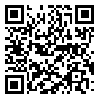Accepted Articles
Back to the articles list |
Back to browse issues page
Saba Niknamfar1 
 , Azarakhsh Mokri2
, Azarakhsh Mokri2 
 , Eisa Nazar3
, Eisa Nazar3 
 , Raheleh Rafaiee4
, Raheleh Rafaiee4 
 , Seyedeh Masoumeh Seyedhosseini Tamijani4
, Seyedeh Masoumeh Seyedhosseini Tamijani4 
 , Seyed Hamzeh Hosseini5
, Seyed Hamzeh Hosseini5 
 , Hamed Ghazvini *4
, Hamed Ghazvini *4 


 , Azarakhsh Mokri2
, Azarakhsh Mokri2 
 , Eisa Nazar3
, Eisa Nazar3 
 , Raheleh Rafaiee4
, Raheleh Rafaiee4 
 , Seyedeh Masoumeh Seyedhosseini Tamijani4
, Seyedeh Masoumeh Seyedhosseini Tamijani4 
 , Seyed Hamzeh Hosseini5
, Seyed Hamzeh Hosseini5 
 , Hamed Ghazvini *4
, Hamed Ghazvini *4 

1- Student Research Committee, School of Advanced Technologies in Medicine, Mazandaran University of Medical Sciences, Sari, Iran.
2- Department of Psychiatry, Faculty of Medicine, Tehran University of Medical Sciences, Tehran, Iran
3- Psychiatry and Behavioral Sciences Research Center, Addiction Institute, Mazandaran University of Medical Sciences, Sari, Mazandaran, Iran
4- Department of Neuroscience, School of Advanced Technologies in Medicine, Mazandaran University of Medical Sciences, Sari, Iran
5- Department of Psychiatry, Psychosomatic Research Center, Sari Imam Khomeini Hospital, Faculty of Medicine, Mazandaran University of Medical Sciences, Sari, Iran
2- Department of Psychiatry, Faculty of Medicine, Tehran University of Medical Sciences, Tehran, Iran
3- Psychiatry and Behavioral Sciences Research Center, Addiction Institute, Mazandaran University of Medical Sciences, Sari, Mazandaran, Iran
4- Department of Neuroscience, School of Advanced Technologies in Medicine, Mazandaran University of Medical Sciences, Sari, Iran
5- Department of Psychiatry, Psychosomatic Research Center, Sari Imam Khomeini Hospital, Faculty of Medicine, Mazandaran University of Medical Sciences, Sari, Iran
Abstract:
Background: Nicotine addiction, driven by cue-induced cravings, significantly contributes to high relapse rates among smokers. Craving, particularly cue-induced craving, plays a critical role in relapse and is influenced by culturally specific environmental cues. This study aims to develop and validate a culturally adapted visual cue-based craving induction task for cigarette smokers to enhance research on nicotine dependence.
Methods: This study included 240 treatment-seeking Iranian smokers (120 males, 120 females) with ≥10 cigarettes/day for ≥2 years, assessed using DSM-5 criteria and the Fagerström Test for Nicotine Dependence. Culturally relevant craving-inducing cues were selected through focus groups and expert validation, categorized into seven groups (Neutral, Instrument, Bill, Smoking, Smoking environment, Smoking Shop, Consumption type). Participants rated craving intensity via a Visual Analog Scale during cue exposure (10-15 sec/image). A final task comprising 30 evocative and 4 neutral cues was developed for standardized craving induction.
Result: The CICT 34 demonstrated significant reliability with Cronbach’s alpha of 70.10% and McDonald's omega of 79%. Significant positive correlations were found between total craving scores and categories such as Smoking, Consumption Type, Instrument, Environment, Bill, and Smoking Shop [P < 0.05]. However, no significant correlation was found between age and craving scores [P > 0.05].
Conclusion: This study showed that visual cues reliably induce nicotine craving, with cue reactivity influenced by addiction severity but not demographic factors. The CICT-34 task is a valid tool for measuring cue-induced craving, highlighting the importance of personalized approaches in tobacco addiction treatment.
Methods: This study included 240 treatment-seeking Iranian smokers (120 males, 120 females) with ≥10 cigarettes/day for ≥2 years, assessed using DSM-5 criteria and the Fagerström Test for Nicotine Dependence. Culturally relevant craving-inducing cues were selected through focus groups and expert validation, categorized into seven groups (Neutral, Instrument, Bill, Smoking, Smoking environment, Smoking Shop, Consumption type). Participants rated craving intensity via a Visual Analog Scale during cue exposure (10-15 sec/image). A final task comprising 30 evocative and 4 neutral cues was developed for standardized craving induction.
Result: The CICT 34 demonstrated significant reliability with Cronbach’s alpha of 70.10% and McDonald's omega of 79%. Significant positive correlations were found between total craving scores and categories such as Smoking, Consumption Type, Instrument, Environment, Bill, and Smoking Shop [P < 0.05]. However, no significant correlation was found between age and craving scores [P > 0.05].
Conclusion: This study showed that visual cues reliably induce nicotine craving, with cue reactivity influenced by addiction severity but not demographic factors. The CICT-34 task is a valid tool for measuring cue-induced craving, highlighting the importance of personalized approaches in tobacco addiction treatment.
Send email to the article author
| Rights and permissions | |
 |
This work is licensed under a Creative Commons Attribution-NonCommercial 4.0 International License. |





